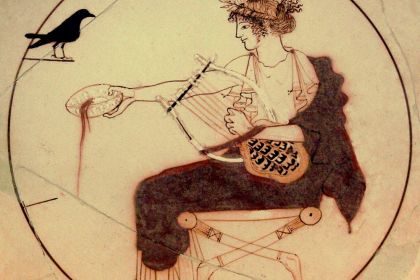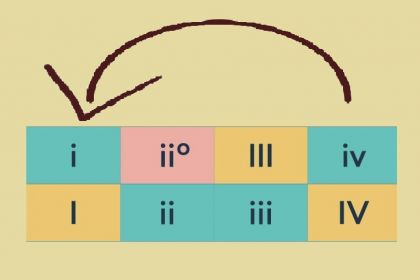Music Theory
7 songs featuring Mixolydian mode

Terracotta amphora attributed to the Berlin Painter
The dominance of the major and minor modes in Western classical music has been observed for several centuries, and this tendency naturally migrated into popular music from the very moment of its inception. Music theory explains that this choice ideally provides the piece both the polyphonic structure and the interaction of diatonic functions, the alternation of which creates tension and resolves it.
In a search for thematic diversity, composers and musicians in nearly every genre have explored folk scales and alternative modes of many world cultures. The diatonic scales such as Phrygian, Lydian, Dorian, and Mixolydian stand out among other modal modes since their structure allows for the organization of the melodies as a horizontal harmony and the formation of accompanying chords in a vertical harmony.
The Mixolydian scale has only one alteration compared to the major scale which explains its major sound. But this change is quite significant since it robs the Mixolydian mode of the leading-tone, so the seventh scale degree—called the subtonic—differs from the tonic by a whole tone.
C Mixolydian scale:


The Mixolydian mode is classified as a major one since the tonic triad that is built on the first scale degree is a major chord. Two more major chords in the Mixolydian mode are rooted in the fourth and seven degrees while the minor triads can be built on the second, fifth, and sixth degrees. For example, C Mixolydian mode contains the following triads (denoted by Roman numerals and chord symbols): I–C, ii–Dm, IIIo–Edim, IV–F, v–Gm, vi–Am, VII–B♭.
The analysis of C Mixolydian mode through the Roman numeric system:

Unlike the major mode, the dominant function of the Mixolidyan mode is often represented by the major subtonic chord, though cadences implemented with it are imperfect. Since the main dominant-family chord of the fifth's scale degree is a minor one, its use in final cadences is minimized and the Mixolydian mode is deprived of the very important perfect authentic cadence.

Unlike the major mode, the dominant function of the Mixolidyan mode is often represented by the major subtonic chord, though cadences implemented with it are imperfect. Since the main dominant-family chord of the fifth's scale degree is a minor one, its use in final cadences is minimized and the Mixolydian mode is deprived of the very important perfect authentic cadence.
A curious example of a developed chord progression in the A Mixolydian (as well as its connection to the major scale) appears in If I Needed Someone by The Beatles. The harmonic analysis of the song's chord chain (denoteв with Roman numerals) shows the following progressions:
- A–G–A or I–VII–I for the verses
- Em–F♯–Bm–Em–F♯–Bm–E or v–VI–ii–v–VI–ii–V for the chorus
In the verses, the chords follow a typical Mixolydian alternation, while the chorus starts with a minor dominant, then cleverly follows up with a powerful classical cadence using a major dominant chord. The Em chord changes to E chord through alteration of the seventh scale degree and then switches the Mixolydian diatonic scale to the major scale. In the chorus, the F♯ chord is marked in red since it does not belong to the Mixolydian mode where the chord built on the sixth scale degree should be minor and not major.
Listen to If I Needed Someone by The Beatles:
L.A. Woman, the title track off the 1971 same-name album by The Doors, is based on the same alternation of two major chords that are built on the first and seventh scales degrees of the A Mixolydian mode: A–G–A or I–VII–I.
Listen to L.A. Woman by The Doors:
Dark Star, one of the most adored tracks by the Grateful Dead, once again showcases the same chord progression built on the first and seventh degrees of the A Mixolydian: A–G or I–VII. The riff, also built on these chords, is heard throughout all the verses except for the second line where the harmony is refreshed by the alternation of the chords built on first and fifth scale degrees: Em–A or v–I.
Listen to Dark Star by Grateful Dead:
Seven Bridges Road, the famous 1980s song written by Steve Young and then arranged by Iain Matthews, reveals another D Mixolydian chord progression: D-C-G-D or I–VII–IV–I. Here, the same chord chain is repeated throughout the song, corresponding to the following sequence of the harmonic functions: T–D–S–T or tonic–dominant–subdominant–tonic.
Listen to Seven Bridges Road performed by Eagles:
Clocks, an iconic Coldplay song that won the Grammy Award in 2002, features the E♭ Mixolydian chord progression accompanying all verses and instrumental sections: E♭–B♭m–Fm or I–v–ii. Only two refrains on the phrase "nothing else compares" are performed in another sequence: G♭–D♭–A♭ or ♭III–VII–IV. Marked in red, the major chord built on a lowered third scale degree does not apply to the Mixolydian mode in which the third scale degree chord is diminished.
Listen to Clocks by Coldplay:
Marquee Moon, released on the 1977 debut album of the rock band Television, mainly revolves around a simple alternation of the two chords built on the first and sixth degrees that can belong to both the major mode and Mixolydian mode: D–Bm or I–vi. This chord combination is invariably repeated during choruses, verses, and instrumental sections, but there are two evident Mixolydian sequences that appear in the bridges:
- Em–C–Am or ii–VII–v
- Em–C–Am–C or ii–VII–v–VII
Listen to Marquee Moon by Television:
Sweet Home Alabama, released on the Lynyrd Skynyrd's second album in 1974, features a chord progression spanning all three major chords of the Mixolydian mode: D–C–G or I–VII–IV. Another chord chain occurs only in the solo and in the second verse as an accent for the "boo-hoo-hoo" line F–C–D or ♭III–VII–I. As in Coldplay's Clocks, the lowered third scale degree is used here in order for the F chord to be built from it. It is marked in red as not belonging to the D Mixolydian.
Listen to Sweet Home Alabama by Lynyrd Skynyrd:
As the examples show, the major chord built in the seventh scale degree of the Mixolydian mode is used very intensively. Another takeaway from this is the nature in which the main subdominant chord rooted in the fourth scale degree is used—it is usually followed by a tonic chord forming a sequence known as a plagal cadence IV–I.
Discover more songs composed in Mixolydian major mode and check out their harmonic analysis in the following articles:
- Mixolydian mode in The Doors songs
- The Bells of Rhymney: two major modal modes of famous protest song
- Seven Seas of Rhye: song of imaginary land brought to life by Ionian and Mixolydian modes




Great additions to the subject!👍
Good stuff but on "Sweet Home Alabama" it makes more sense to me to treat the whole thing as a reverse I-IV-V and think of it as G major (same notes as D mixolydian) as far as feel and throw in those passing tones like the b3.